If you wanna read this content in English, click here.
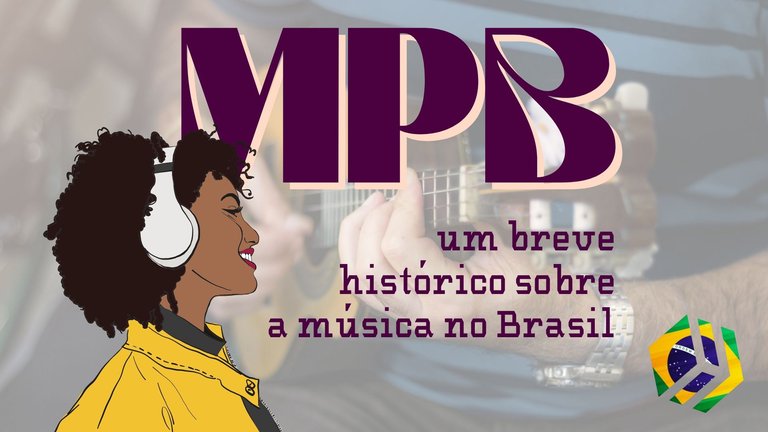
[PT]
Hey! Hoje vamos conversar um pouco sobre a história da cultura musical no nosso país, uma espécie de linha do tempo onde veremos a evolução entre os estilos e suas influências históricas, vamos nessa?
Música indígena pré-colonial
Antes de começar, acho importante falar que vamos abordar mais a história da música no Brasil após a chegada dos portugueses. Temos muito poucos registros da história da música dos indígenas, e como tínhamos muitas tribos, elas tinham significados diferentes para a música. Vamos falar rapidinho sobre a música do povo indígena antes da chegada dos portugueses em 1500.
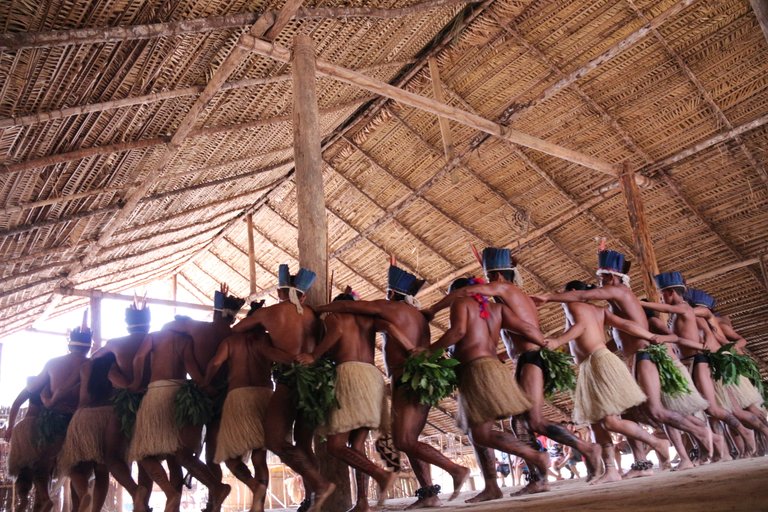
Fonte da imagem: https://w.wiki/AEGA
A música indígena tinha um sentido muito mágico e místico. Era considerada por muitas tribos como um presente dos deuses ou como algo originado do mundo dos sonhos, onde viviam os ancestrais. Era sempre uma questão muito mística, sobre deuses e criação. A música era usada para rituais de cura, exorcismo e até mesmo socialização da tribo. Como variava muito entre as tribos e temos poucos registros, essa é só uma passada rápida pela música indígena antes de 1500.
Influências portuguesas e os primeiros estilos musicais
Agora vamos começar com a chegada dos portugueses e avançar até a música mais moderna que temos hoje. Falando de música brasileira de fato, podemos começar a partir do século XVIII. Antes disso, as músicas que existiam aqui, por ser uma colônia, eram músicas trazidas pelos portugueses. Os estilos desenvolvidos depois também tiveram muita influência dessa cultura trazida anteriormente pelos europeus.
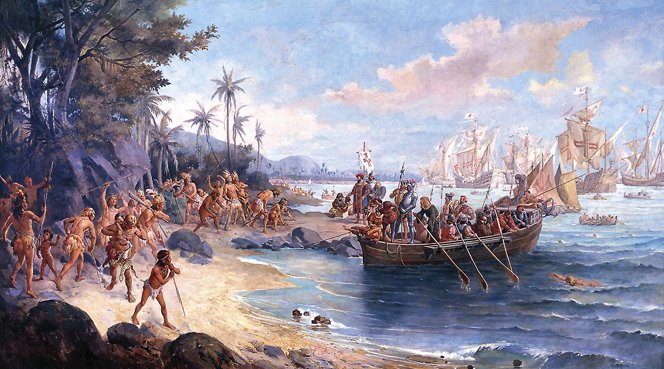
Fonte da imagem: https://w.wiki/AEG8
No século XVIII, temos basicamente três estilos musicais: a Modinha, o Lundu e a música religiosa. O Lundu é uma dança trazida pelos escravos bantos, apropriada pelos membros da corte e que acabou se tornando uma forma de canção e dança de salão na corte. O Lundu tinha um andamento mais rápido, era mais sensual e foi influenciado por músicas europeias trazidas pela corte, como a Valsa e a Scottish. Esses estilos começaram a se popularizar no Brasil depois de 1840.
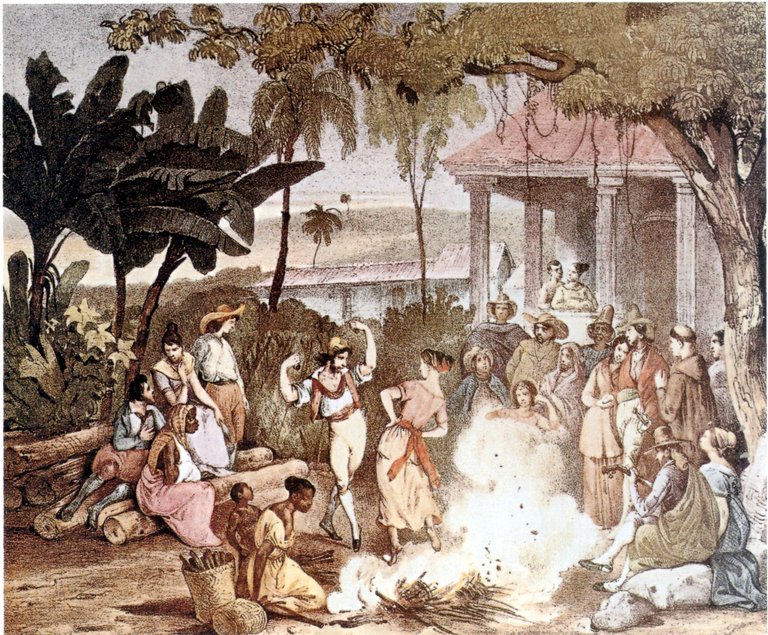
Fonte da imagem: https://w.wiki/AEG3
A Modinha surge mais para o fim do século XVIII, sendo uma variação da Moda Portuguesa. O inventor foi um brasileiro, Domingos Caldas Barbosa, que substituiu o estilo da Moda Portuguesa por características do Lundu e uma linguagem mais solene nas letras, já que era apresentada pelos membros da corte. A Modinha tinha uma característica mais melancólica e erudita, principalmente na época do Segundo Império, sendo quase uma obra operística.
A música religiosa
Apesar desses dois estilos serem dominantes, por causa da influência da corte, também havia uma música religiosa muito forte, principalmente em Minas Gerais, trazida pela Igreja Católica e pelos padres que vieram catequizar os índios. As músicas religiosas eram tocadas por negros e mestiços, organizados em irmandades religiosas, e eram sofisticadas, abordando temas católicos.
A chegada da família real portuguesa
No começo do século XIX, em 1808, acontece a vinda da família real portuguesa, fugindo de Napoleão. Isso traz muitas influências da música europeia, diversificando a música em toda a colônia. Eles trazem influências da Música Clássica Germânica e da Ópera Napolitana, muito em alta na época. Isso fez com que as pessoas no Brasil começassem a ouvir e consumir esse tipo de música.

Fonte da imagem: https://w.wiki/AEGD
Música como profissão e a influência do Romantismo
É importante ressaltar que, nesse período, a música não era vista como uma atividade profissional. Ninguém trabalhava como músico, especialmente por causa da escravidão. Os músicos eram, na maioria, escravos. A visão era que tocar música não necessitava de intelecto, apenas a manipulação de um instrumento, e por isso os músicos eram escravos.
Essa visão começa a mudar no Brasil no meio do século XIX, entre 1840 e 1850, com a influência do Romantismo europeu. Temos então Carlos Gomes, o primeiro brasileiro a ser conhecido mundialmente. Ele era um compositor de Ópera, comparado aos italianos, os principais compositores da época. A Ópera agradava muito à corte, o que aumentava ainda mais sua fama.
Fonte da imagem: https://w.wiki/AEGK
Surgimento dos conservatórios de música
É nessa época também que surgem os primeiros conservatórios de música no Brasil. Em 1848, surge o Conservatório Musical do Rio de Janeiro e, em 1857, a Imperial Academia de Música e Ópera Nacional. Esses conservatórios contribuíram para estruturar a música no Brasil, principalmente a música erudita.
Ainda assim, a maior parte das pessoas que tocavam instrumentos e faziam músicas eram os negros, muitos ainda escravos. Eles aprendiam e se tornavam músicos qualificados. Surgiu então, nessa mesma época, a Real Fazenda de Santa Cruz, um conservatório de música para escravos, onde eles aprendiam a tocar para agradar seus donos e a corte. Com isso, uma tradição musical complexa foi criada por negros e mestiços da corte, que começaram a criar novos estilos musicais, misturando influências europeias com as que já conheciam.
A popularização do piano e a mistura de influências
Essa mistura de influências fez com que a música no Rio de Janeiro, capital do Brasil na época, se tornasse mais alegre do que a Modinha, que era melancólica. Nessa época, o piano começou a se popularizar no Brasil, iniciando a estruturação da indústria musical no país. Um fato importante sobre a febre do piano é que todo mundo que era rico, membro da corte na época, tinha que ter um piano em casa. Era mais uma questão de etiqueta social do que realmente para ser tocado.
O surgimento do Samba
Um dos primeiros estilos mais modernos que temos até hoje, que vem muito dessa mistura da música negra dos escravos, é justamente o Samba. Inclusive, a palavra "Samba" era o nome de uma festa de escravos, uma festa de danças do povo negro da época, principalmente na Bahia. Com a migração dos escravos vindos da Bahia para o Rio de Janeiro, que ainda era a capital, além de ser incorporado o nome "Samba" ao estilo musical, surgiu ali a primeira geração de sambistas. Entre os principais nomes estão João da Baiana, Donga, Pixinguinha, entre outros.
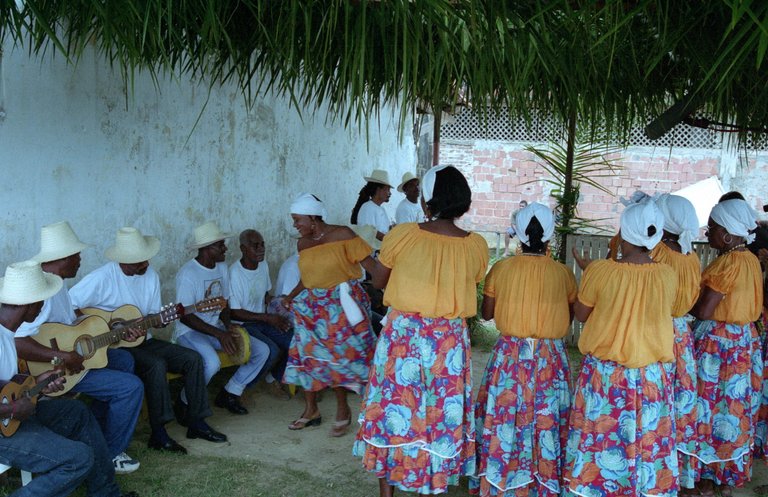
Fonte da imagem: https://w.wiki/AEGM
Evolução do Samba e as primeiras escolas de Samba
As mudanças no Samba não foram apenas musicais, mas também culturais e sociais. Nos anos 1930, surge o Samba de Estácio, que seria a primeira geração do Samba Raiz. Esta geração tira o Samba da música folclorizada e busca influências europeias. Entre os primeiros compositores famosos dessa época estão Ismael Silva, Bide, Armando Vieira Marçal, entre outros. Essa geração é importante porque fez com que o Samba entrasse no cenário musical, começando a fazer shows e tocar no rádio. Eles também são os fundadores das primeiras escolas de Samba, que têm grande importância sociocultural até hoje.
A popularização do rádio e a diversificação musical
Nos anos 1940 à 1950, com a popularização do rádio, a música começou a se difundir mais, principalmente entre as classes populares nas grandes cidades. Nesse momento, temos uma maior penetração de músicas estrangeiras, como o Jazz, Rumba, Bolero, por exemplo. É também nessa época que surgem músicas mais regionalizadas, como o Baião, que surgiu no Nordeste. Luiz Gonzaga é um dos principais nomes que popularizou o Baião, que também deu origem ao Forró Pé-de-Serra, Xaxado e o Xote.
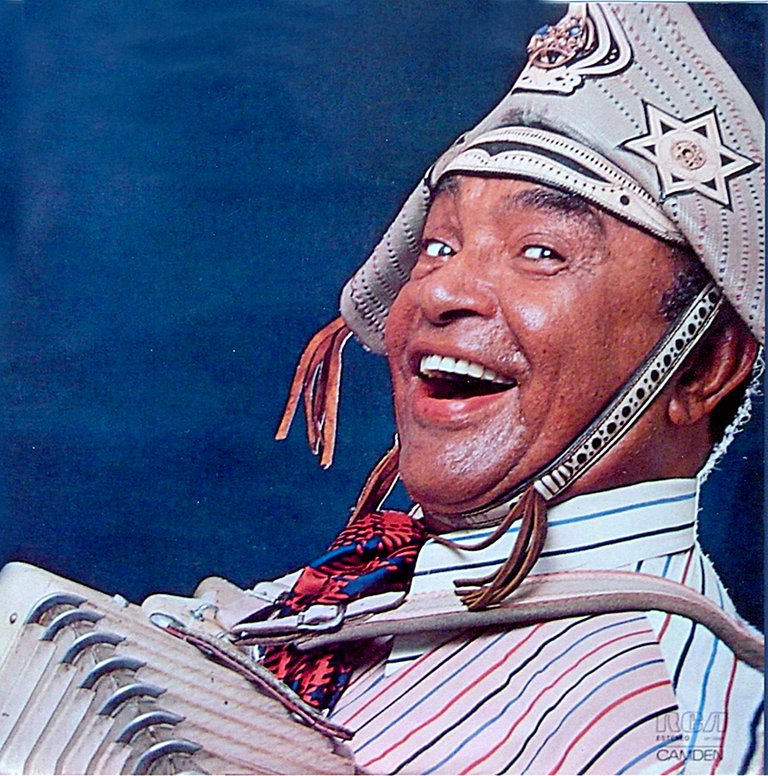
Fonte da imagem: https://w.wiki/AEGN
No interior do Brasil, começa a surgir a Moda de Viola, influenciada pela Moda Portuguesa e pelos jesuítas que usavam a viola para catequizar os índios. Dessa influência, desenvolveu-se a Viola Caipira e a Música Sertaneja. Com a popularização do rádio, essas músicas regionalizadas começaram a se espalhar pelo Brasil.
O surgimento da MPB e da Bossa Nova
Já nos anos entre 1950 e 1960, temos o surgimento da MPB (Música Popular Brasileira), que inclui o movimento da Bossa Nova. A Bossa Nova buscava modernizar a música, simplificando-a e trazendo uma maior importância aos instrumentos. As letras eram narrativas e funcionais, refletindo um pensamento crítico da época.
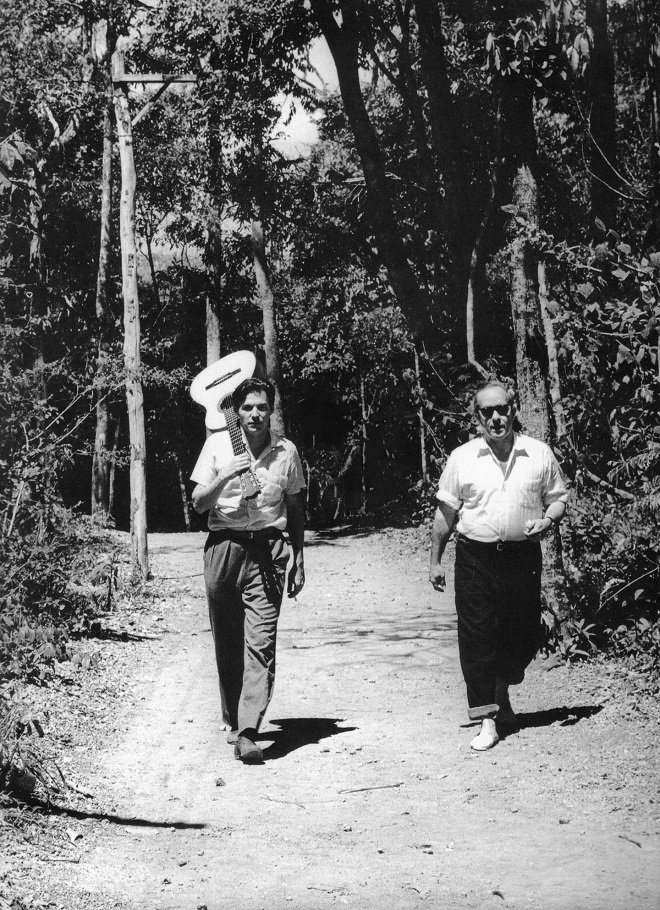
Fonte da imagem: https://w.wiki/AEGa
Nos anos de 1960, com a popularização da Bossa Nova, juntaram-se os estilos que estavam fazendo sucesso, formando a MPB como conhecemos. Esse movimento buscava nacionalizar a música e trazer essa ideia para todos os estilos musicais. Surgiram também novas ramificações da Bossa Nova, como a Tropicália, que influenciou não só a música, mas também o cinema e as artes plásticas. A Tropicália foi um movimento que buscava as origens do Brasil e utilizava elementos estrangeiros, o que gerou críticas por parte dos autores e fãs da MPB.
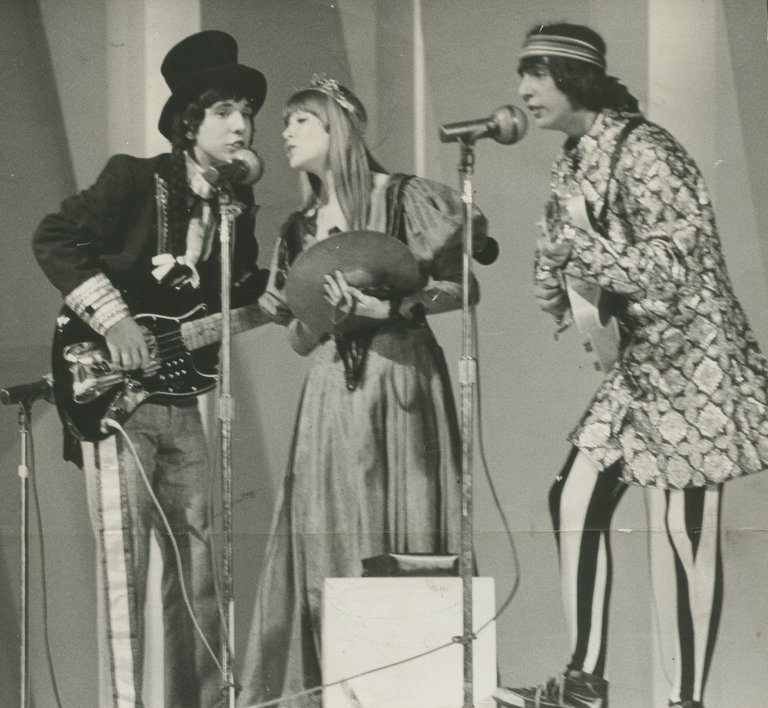
Fonte da imagem: https://w.wiki/AEHB
Repressão e crise na indústria musical
Com o golpe militar em 1964 e o endurecimento em 1968, houve repressão aos artistas, como Gilberto Gil, Caetano Veloso e Geraldo Vandré. A perseguição aos artistas e a crise na indústria musical no final dos anos 1960 e começo dos anos 1970 fizeram com que a inovação na música fosse menos aceita. O Tropicalismo acabou sendo incorporado na MPB, deixando de ser um gênero específico.
Pop-Rock brasileiro e Jovem Guarda
Nos anos 1970, surge o Pop-Rock brasileiro, influenciado pela contracultura. Bandas como Novos Baianos, Raul Seixas, Rita Lee e Os Mutantes se destacam. A música romântica também se populariza, trazendo influências da Jovem Guarda. Apesar de incorporado na MPB, o Samba ainda mantinha uma forte tradição independente, com nomes como Martinho da Vila, Beth Carvalho e Paulinho da Viola, valorizando artistas antigos como Cartola e Nelson Cavaquinho.
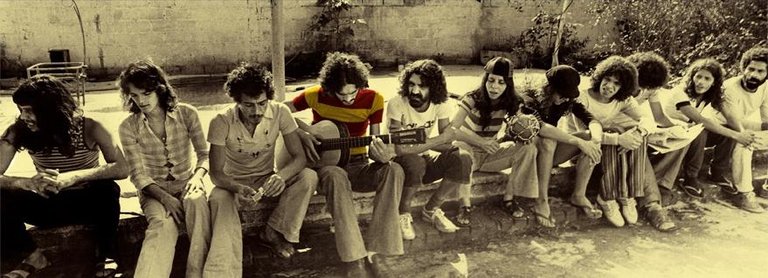
Fonte da imagem: https://w.wiki/AEH4
Baile Funk e as influências da Soul Music
No final dos anos de 1970, a Soul Music americana populariza os primeiros bailes Funk no Rio de Janeiro. Com a popularização da MPB, os bailes Funk se deslocaram para o subúrbio. O DJ Marlboro foi fundamental ao mudar a batida do Funk para um estilo mais brasileiro, usando bateria eletrônica.
Novos movimentos e ramificações na década de 1980
Entrando nos anos de 1980, muita coisa aconteceu: o surgimento do Rock de Brasília, o Pagode nos anos de 1990 e a ramificação de estilos musicais. Agora, achamos interessante começar a trazer conteúdos sobre o surgimento de alguns estilos musicais mais atuais nos próximos posts. Deixe sua sugestão aí nos comentários para sabermos quais estilos, instrumentos e até mesmo grupos musicais você quer que falemos no futuro. Belezeira?
Esperamos que tenha gostado. Conta pra gente... Qual o seu estilo de música favorito? Você toca algum instrumento? Adoraríamos conhecer a nossa comunidade, imagina como deve ser diversa culturalmente...
Um forte abraço e até a próxima.

Hey! Today we're going to talk a little about the history of musical culture in our country, a kind of timeline where we will see the evolution of styles and their historical influences, shall we?
Pre-colonial Indigenous Music
Before starting, I think it's important to mention that we will mostly discuss the history of music in Brazil after the arrival of the Portuguese. We have very few records of the history of indigenous music, and since we had many tribes, they had different meanings for music. I'll briefly talk about the music of the indigenous people before the arrival of the Portuguese in 1500.

Fonte da imagem: https://w.wiki/AEGA
Indigenous music had a very magical and mystical sense. It was considered by many tribes as a gift from the gods or something originating from the dream world, where the ancestors lived. It was always a very mystical matter, about gods and creation. Music was used for healing rituals, exorcism, and even the socialization of the tribe. Since it varied greatly among tribes and we have few records, this is just a quick overview of indigenous music before 1500.
Portuguese Influences and Early Musical Styles
Now let's start with the arrival of the Portuguese and move forward to the more modern music we have today. Talking about Brazilian music, we can start from the 18th century. Before that, the existing music here, being a colony, was music brought by the Portuguese. The styles developed later were also heavily influenced by this previously brought European culture.

Fonte da imagem: https://w.wiki/AEG8
In the 18th century, we basically have three musical styles: the Modinha, the Lundu, and religious music. The Lundu is a dance brought by Bantu slaves, appropriated by court members and eventually becoming a form of song and ballroom dance at court. The Lundu had a faster tempo, was more sensual, and was influenced by European music brought by the court, such as the Waltz and the Scottish. These styles began to become popular in Brazil after 1840.

Fonte da imagem: https://w.wiki/AEG3
The Modinha emerged towards the end of the 18th century, being a variation of the Portuguese Moda. The inventor was a Brazilian, Domingos Caldas Barbosa, who replaced the style of the Portuguese Moda with characteristics of the Lundu and a more solemn language in the lyrics, as it was presented by court members. The Modinha had a more melancholic and erudite character, especially in the Second Empire period, being almost an operatic work.
Religious Music
Despite these two dominant styles, due to the influence of the court, there was also very strong religious music, especially in Minas Gerais, brought by the Catholic Church and the priests who came to catechize the indigenous people. Religious music was played by blacks and mestizos, organized into religious brotherhoods, and was sophisticated, addressing Catholic themes.
The Arrival of the Portuguese Royal Family
At the beginning of the 19th century, in 1808, the Portuguese royal family arrived, fleeing from Napoleon. This brought many European musical influences, diversifying music throughout the colony. They brought influences from German Classical Music and Neapolitan Opera, which were very popular at the time. This made people in Brazil start to listen to and consume this type of music.

Fonte da imagem: https://w.wiki/AEGD
Music as a Profession and the Influence of Romanticism
It is important to note that, during this period, music was not seen as a professional activity. No one worked as a musician, especially because of slavery. Musicians were mostly slaves. The view was that playing music did not require intellect, just the manipulation of an instrument, and therefore musicians were slaves.
This view began to change in Brazil in the mid-19th century, between 1840 and 1850, with the influence of European Romanticism. We then have Carlos Gomes, the first Brazilian to be known worldwide. He was an Opera composer, compared to the Italians, the main composers of the time. Opera greatly pleased the court, which further increased his fame.
Fonte da imagem: https://w.wiki/AEGK
Emergence of Music Conservatories
It was also during this time that the first music conservatories emerged in Brazil. In 1848, the Conservatório Musical do Rio de Janeiro was founded, and in 1857, the Imperial Academia de Música e Ópera Nacional. These conservatories contributed to structuring music in Brazil, mainly classical music.
Still, most of the people who played instruments and made music were blacks, many still enslaved. They learned and became skilled musicians. Thus, around this same time, the Real Fazenda de Santa Cruz was established, a music conservatory for slaves, where they learned to play to please their masters and the court. Consequently, a complex musical tradition was created by blacks and mestizos of the court, who began to create new musical styles, mixing European influences with what they already knew.
The Popularization of the Piano and the Mix of Influences
This mix of influences made music in Rio de Janeiro, the capital of Brazil at the time, become more cheerful than the Modinha, which was melancholic. During this period, the piano began to become popular in Brazil, initiating the structuring of the country's music industry. An important fact about the piano fever is that everyone who was rich, a member of the court at the time, had to have a piano at home. It was more a matter of social etiquette than actually for playing.
The Emergence of Samba
One of the first more modern styles we have today, which comes a lot from this mix of slave music, is precisely Samba. In fact, the word "Samba" was the name of a slave party, a dance party of black people at the time, mainly in Bahia. With the migration of slaves from Bahia to Rio de Janeiro, which was still the capital, besides incorporating the name "Samba" into the musical style, the first generation of sambistas emerged there. Among the main names are João da Baiana, Donga, Pixinguinha, among others.

Fonte da imagem: https://w.wiki/AEGM
Evolution of Samba and the First Samba Schools
The changes in Samba were not only musical but also cultural and social. In the 1930s, the Samba de Estácio emerged, which would be the first generation of Samba Raiz. This generation took Samba out of folklorized music and sought European influences. Among the first famous composers of this era are Ismael Silva, Bide, Armando Vieira Marçal, among others. This generation is important because it brought Samba into the musical scene, starting to perform shows and play on the radio. They are also the founders of the first Samba schools, which have great socio-cultural importance to this day.
The Popularization of Radio and Musical Diversification
In the 1940s and 1950s, with the popularization of radio, music began to spread more, especially among the popular classes in big cities. At this time, we have a greater penetration of foreign music, such as Jazz, Rumba, Bolero, for example. It is also at this time that more regionalized music styles, such as Baião, which emerged in the Northeast, started to appear. Luiz Gonzaga is one of the main names who popularized Baião, which also gave rise to Forró Pé-de-Serra, Xaxado, and Xote.

Fonte da imagem: https://w.wiki/AEGN
In the interior of Brazil, the Moda de Viola began to emerge, influenced by the Portuguese Moda and by the Jesuits who used the viola to catechize the indigenous people. From this influence, the Viola Caipira and Música Sertaneja developed. With the popularization of radio, these regionalized music styles began to spread throughout Brazil.
The Emergence of MPB and Bossa Nova
Already in the 1950s and 1960s, we have the emergence of MPB (Música Popular Brasileira), which includes the Bossa Nova movement. Bossa Nova sought to modernize music, simplifying it and giving greater importance to instruments. The lyrics were narrative and functional, reflecting a critical thought of the time.

Fonte da imagem: https://w.wiki/AEGa
In the 1960s, with the popularization of Bossa Nova, the styles that were successful came together, forming MPB as we know it. This movement sought to nationalize music and bring this idea to all musical styles. New branches of Bossa Nova, such as Tropicália, also emerged, influencing not only music but also cinema and the visual arts. Tropicália was a movement that sought the origins of Brazil and used foreign elements, which generated criticism from MPB authors and fans.

Fonte da imagem: https://w.wiki/AEHB
Repression and Crisis in the Music Industry
With the military coup in 1964 and the tightening in 1968, there was repression of artists such as Gilberto Gil, Caetano Veloso, and Geraldo Vandré. The persecution of artists and the crisis in the music industry in the late 1960s and early 1970s made innovation in music less accepted. Tropicalismo ended up being incorporated into MPB, ceasing to be a specific genre.
Brazilian Pop-Rock and Jovem Guarda
In the 1970s, Brazilian Pop-Rock emerged, influenced by counterculture. Bands like Novos Baianos, Raul Seixas, Rita Lee, and Os Mutantes stood out. Romantic music also became popular, bringing influences from Jovem Guarda. Despite being incorporated into MPB, Samba still maintained a strong independent tradition, with names like Martinho da Vila, Beth Carvalho, and Paulinho da Viola, valuing old artists like Cartola and Nelson Cavaquinho.

Fonte da imagem: https://w.wiki/AEH4
Baile Funk and the Influences of Soul Music
In the late 1970s, American Soul Music popularized the first Baile Funk parties in Rio de Janeiro. With the popularization of MPB, Baile Funk parties moved to the suburbs. DJ Marlboro was instrumental in changing the beat of Funk to a more Brazilian style, using electronic drums.
New Movements and Branches in the 1980s
Entering the 1980s, a lot happened: the emergence of Rock from Brasília, Pagode in the 1990s, and the branching of musical styles. Now, we find it interesting to start bringing content about the emergence of some more current musical styles in future posts. Leave your suggestion in the comments to let us know which styles, instruments, and even musical groups you want us to talk about in the future. Cool?
We hope you enjoyed it. Tell us... What is your favorite music style? Do you play any instruments? We would love to get to know our community, imagine how culturally diverse it must be...
A big hug and see you next time.

Posted Using InLeo Alpha








